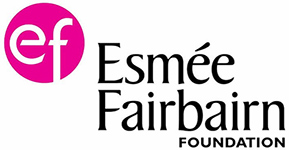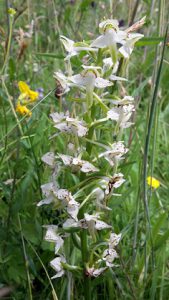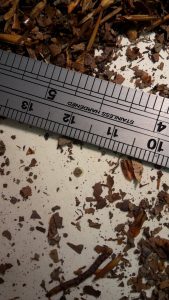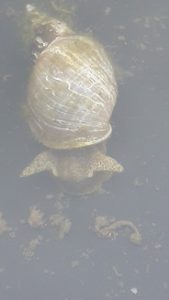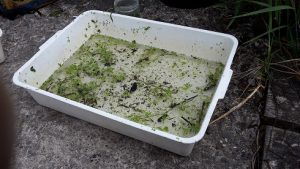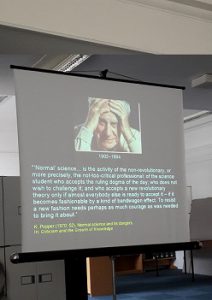
This month has been an exciting one full of mollusc madness, with lots of time out and about in the field. I’ve now managed to complete sampling in two of my three Living Landscape areas, messed around in a boat, used a giant hoover for insects, learnt a lot about midge larvae(?!), philosophised about science and DNA, and hung out with other trainees.
Gwent Wildlife Trust ‘Living Landscape’: Usk to Wye. Sucking up snails!
In this area I decided to look at two reserves; Pentwyn Farm and Wyeswood Common. Both are very interesting reserves and very contrasting. Pentwyn Farm is a stunning grassland reserve of beautiful traditionally managed hay meadows. I was blown away by the amazing range of flowers in the meadows on my first visit, including many species of Orchid. In fact many of the meadows appeared to contain more flowers than grass!
The neighbouring Wyeswood Common is a recent purchase by the Wildlife Trust, and is still very much improved grassland, with little plant diversity. Gwent Wildlife Trust have taken on an ambitious project to increase diversity at the site and make it more wildflower rich. This is a process that could takeover 100 years to fully achieve! I was keen to compare the sites with each other so we could see where they are now and what Wyeswood Common could aspire to if Pentwyn did prove more diverse with mollusc species.
Here I decided to look at the diversity and abundance of grassland slugs and snails. To do that we decided to use a very novel method; using a suction sampler. This is like a large vacuum cleaner, sucking up insects from grass. Entomologists like to use this for studies of insects, but as far as we could work out this would be the first time it was used to look at molluscs. It worked amazingly well at sucking up all the tiny snails that would normally take a long time to find searching by hand. It also handled some of the bigger slugs well. With the help of Dr Ben Rowson, I came up with a survey design of timed samples from each meadow… and we were off!
We soon discovered that sampling these sites would be a race against time, as they were due to mown this month. This could potentially affect our results, as shorter grass means it would be drier, causing snails to squeeze down into the earth more to avoid drying out. This would make them harder to suck up! It also meant that snails could possibly be picked off by birds more easily. Luckily a couple of volunteers kindly stepped in to help us get sampling completed in time: SEWBrEC’s LEMUR+ trainee Laura, and work experience student Harry.
Now that sampling is complete at these reserves, I look forwards to sitting down and identifying the tiny snails we found under the microscope in the near future.
‘Living Landscape’: Gwent Levels. Returning to Magor Marsh in hunt of mussels
Back in May I finished collecting samples at Magor Marsh… or so you thought! What we hadn’t managed to sample was the pond area, something we decided we would need a boat for. After liaising with the enthusiastic site manager, who willingly provided a small rowing boat, and carrying out risk assessments galore we set a date. We were hoping to use a small grab to dredge parts of the pond, but locating someone with one turned out to be an impossible feat… so we made our own simple version of a dredge.
Meanwhile, in the search for a dredge we discovered that the museum has a sediment corer languishing in a corner longing to be used. We decided to try this out at Magor Marsh to see if we could get any interesting information on what dead shells might be lurking in the deep mud, and if any of them are species no longer found at the site. I have to admit this was a daunting idea. This was not because of the method but because the equipment was quite heavy and needed to be put over the side of a small rowing boat. Needless to say there were visions of us ending up in the water, with all our lovely equipment at the bottom of the pond… On the day, disaster struck…. in the form of a heavy rain shower, but once that had passed everything went perfectly, with no boating accidents!
This was an experience that both Ben and I hadn’t even imagined doing when I started my traineeship! It was a great opportunity and fantastic to carry out. Thanks a million to Ben Rowson of National Museum Wales for sourcing equipment for this hare-brained scheme and risking getting in to boat with me, Richard Bakere of Gwent Wildlife Trust for supplying the boat and being on call, and my intrepid volunteers who helped the day go smoothly. Sadly there were no signs of any of the larger freshwater mussel species, but we still got some fascinating data I look forwards to sharing later in my traineeship.
‘Living Landscape’: Eastern Valleys. Sieving for snails
At the end of last month we headed to Silent Valley nature reserve to check it out. Here I collected a test leaf litter sample to have a go at sifting through looking for tiny snails. I’m planning to head back with good company in September to start some sampling in my final Living Landscape area… Watch this space!
Non-biting midges and other freshwater invertebrates
Back at the end of June I headed back across to the Natural History Museum in London to spend some time learning how to identify other freshwater invertebrates. There are many freshwater invertebrates in my samples from the Gwent Levels that I would love to be able to identify. During my four days there I learnt a lot about sampling freshwater habitats and identifying the invertebrates you find.
The curator leading the course was particularly interested in Chironomids (Non-biting midges), which are cool in that you can use their larvae and fossilised remains to track water quality. These were interesting to identify, as they had to be treated, mounted on glass slides, with the shape of the jaw and teeth looked at to identify them. This was very different experience to slugs and snail identification, which usually only needs a binocular microscope and low power magnification at most!
Fun in sunny Leeds!
At the beginning of the month, I excitedly headed off to Leeds for a meet up with some of the other Natural Talent trainees and the numerous Natural Network’s trainees. This was a great experience, not only to share experiences and skills, but also to visit the stunning TCV Skelton Grange centre. This lovely gem is tucked away on an industrial state only c.10 mins drive from the centre of Leeds. It is an amazing example of how a neglected area of grassland can be turned into a rich range of habitats and outdoor education spaces, complete with a wonderful environmental education centre. I particularly loved the outdoor musical instruments made from reused materials!
During our visit we had a cracking barbecue, and then dived in to delivering some informal training. I was thrilled at how many people joined me to hear about identifying slugs! It was great to inspire others and to answer some very interesting questions.
I also got to share ideas and learn other skills, such as identifying mammal poos by smell, taking part in a foraging walk, making nettle soup, identifying bumblebees and much more. We also spent some time presenting our work and projects so far to each other. It was fascinating to discover what everyone has been up to. Each placement is so unique!
While the weekend was incredibly fun and inspiring, it was also tinged with a little sadness as we bid farewell to John MacFarlane. John has been overseeing the Natural Talent programme for many years. He has now moved on to his own business venture of a gourmet burger van, and we all wish him the best of luck. His passion, jokes and enthusiasm will be sorely missed!
Vibrant visitors
It’s been a wonderful month for visitors! As mentioned earlier, we’ve had visits from SEWBrEC’s LEMUR+ trainee Laura, and work experience student Harry. As well as helping with sampling in the field, they were also kind enough to give me a hand in the lab sorting through my aquatic samples. I’ve also been lucky enough to have lots of help from regular museum volunteer Seren with this. She has been amazing at helping me work through the samples, picking out any molluscs for me to identify later.
Later in the month we also had a visit to Entomology from the lovely Rebecca Cairns, a Natural Talent trainee based with Science and Advice for Scottish Agriculture (SASA) in Edinburgh. It was great to meet up, show her around Mollusca and chat about our very different traineeships. Each one in this programme really is a unique experience!
Marshy Monday
In late July I headed back to Magor Marsh (such a great nature reserve!) to take part inthe first “Marshy Monday”. These are sessions run by Gwent Wildlife Trust for children during the school holidays. The one I attended was slug and snail themed, so I had a great time answering questions and leading some pond dipping – always a popular activity! I had a really fun day out and another great experience of working with children and families.
How do we define how species relate to one another?
Back in the museum I got to join in a very interesting workshop on the “Philosophy of Systematics” led by Kirk Fitzhugh. This was a pre-conference workshop, held the week before National Museum Wales Cardiff held host to the 12th International Polychaete Conference. It was a great opportunity to gain insight into a complicated but fascinating subject.
This was exploring the ideas and potential flaws in the methods behind phylogenetics: the study of evolutionary history/relationships between individual or groups of organisms. My first encounter with Philosophy and Science – and not an easy subject! While I found some of the material challenging, I am certain it will be something I keep coming back to in the future.
Kirk’s attitude and approach to the way DNA is used in classifying organisms into different groups is very thought provoking. He pointed out that using DNA analysis is often represented as finding the ‘truth’ and ‘solution’ to how different species are related. Frequently this doe not take into account physical characteristics and features, and therefore ignores the need in science for complete evidence.
He also observed that these findings are treated as fact, when they are actually hypotheses: proposed explanations based on limited information. I hope my interpretation here has been accurate! I look forward to discussing these ideas with my supervisor at the museum, and exploring his views on it. Overall, what I took away from the workshop was a reminder to be critical in your approach to science and common methods – don’t be afraid to question widely adopted ideas!
The end of another busy and fascinating month of my traineeship. I’ve been loving every moment so far! August is lining up to be another exciting month full of travel, adventure and much more mollusc madness…
Until next time!
Hwyl fawr am nawr!
Imogen Cavadino
Natural Talent Trainee: Non-Marine Molluscs
Don’t forget you can keep up to date with my daily antics on Twitter here or here.
A massive thank you to the Esmée Fairbairn Foundation for funding this amazing programme. Find out more about them here.
Also to National Museum Wales for hosting my placement. Be sure to drop in for a visit to the public collections when you’re in Cardiff!
